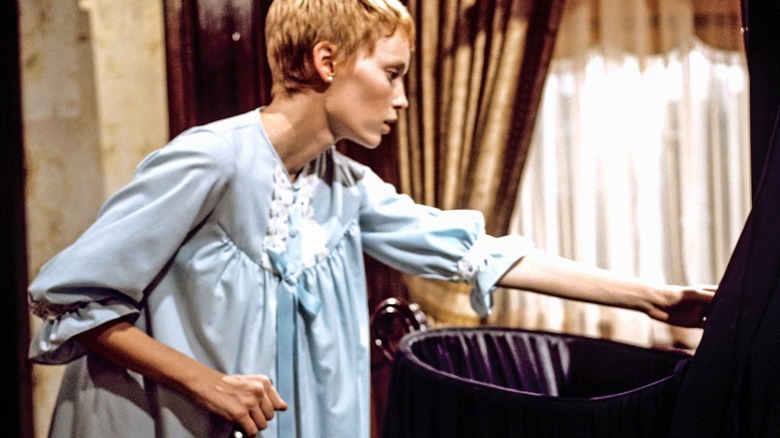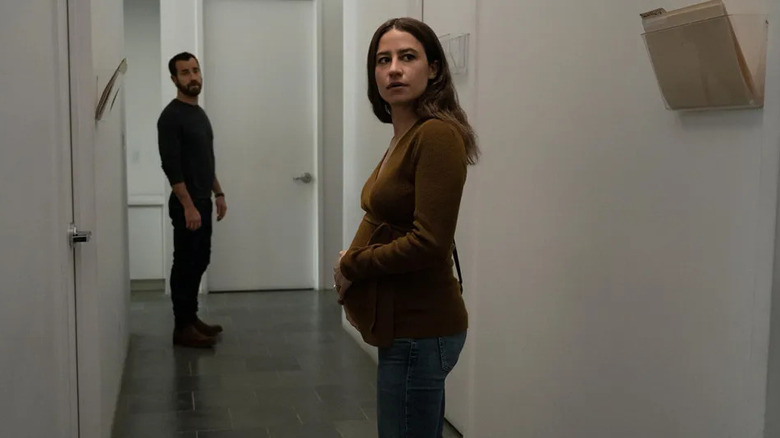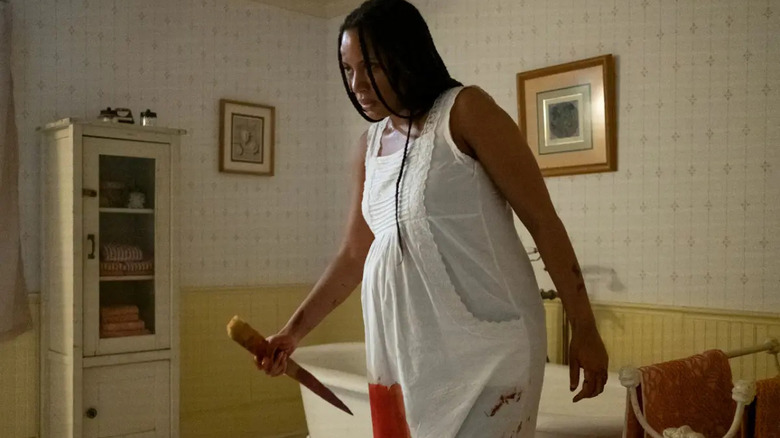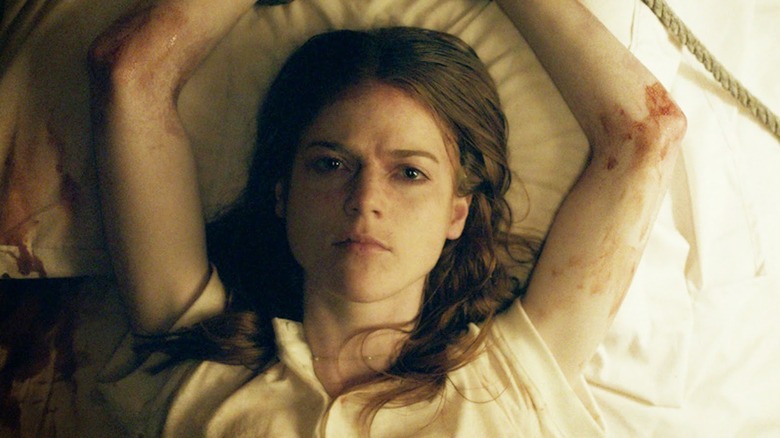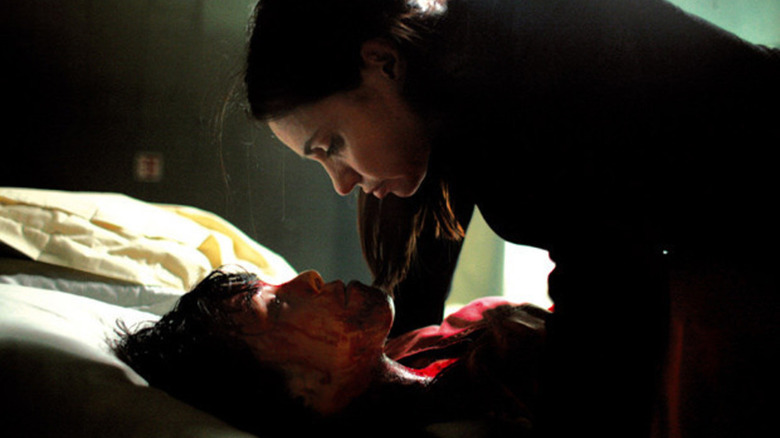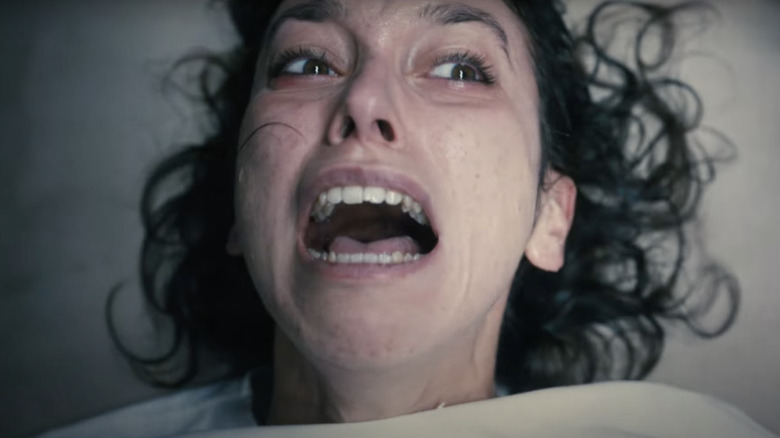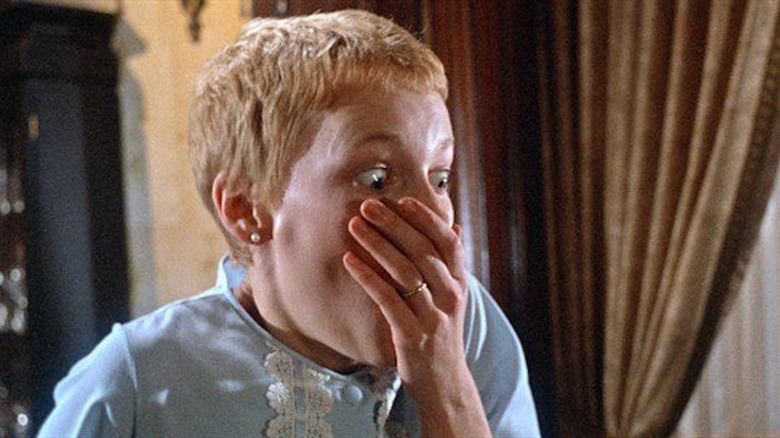The Craziest Horror Pregnancies Ranked (Including The First Omen)
While pregnancy is touted as one of the most beautiful aspects of life, the journey toward the reward of a bouncing baby is not always smooth. Although considered one of the most "natural" things in the world, the act of pregnancy has symptoms that are strange, physically and emotionally draining, and even life-or-death. There's a user on TikTok referred to as "The Girl with the List" who keeps a list of currently over 300 ways pregnancy and childbirth can ravage your body and mind: making you sick, stretching your skin, feeling like sharp pains in your back, swelling your ankles, losing your hair, weakening your nails, and on and on.
There's something very unsettling about a whole other person growing and moving inside you, absorbing your nutrients, changing who you are inside and out, and then being expelled from your body — sometimes in a violent manner. It's no wonder the horror genre keeps using pregnancy as a story device. The list below includes several great films with the craziest pregnancies, featuring gore, supernatural elements, or absurd scenarios that become even more intense with the looming threat of childbirth.
Major spoilers follow.
8. False Positive
A difficult aspect of pregnancy is actually being able to conceive, which for many women is fraught with struggles and sadness — particularly when surrounded by blissful mothers in your friend circle or on social media. "False Positive" uses horror to showcase the uncertainty of infertility and the occasionally predatory or ethically dubious nature of fertility treatment. A sleek-haired Ilana Glazer is nearly unrecognizable as Lucy, a Manhattan writer who sees renowned fertility specialist Dr. John Hindle.
After she undergoes artificial insemination with Hindle's "special technique," she discovers she is pregnant with triplets — far more than the single blessing she was hoping for. However, Hindle recommends selective reduction for a safer pregnancy and delivery, forcing Lucy to pick which fetuses to keep or terminate. "False Positive" showcases how important reproductive freedom is for women, but how difficult and emotionally taxing those types of choices still may be. Multiple pregnancies often come with considerable physical risks, including preterm birth and increased likelihood of gestational diabetes.
Like many other pregnancy horror films, "False Positive" depicts nightmarish symptoms such as excessive bleeding, strange visions, and memory lapses. There's also Lucy's upsetting lack of autonomy. Her husband insists on remaining in Dr. Hindle's cold, clinical care, despite her preference for a more empathetic and holistic female midwife. Dr. Hindle discourages Lucy from researching her concerning symptoms or seeking a second opinion. Everyone dismissively tells Lucy she's just suffering from "mommy brain." These are little, everyday horrors that many pregnant women have to endure. What unfolds with Dr. Hindle is based on chilling true events that convey the sheer terror of having something implanted and expelled from your body that does not belong there.
7. Delivered
"Delivered" is part of Blumhouse's "Into the Dark" anthology series of horror films based on specific holidays. The Mother's Day feature is a pregnant woman's version of "Misery." Like many new expectant mothers, Val has a lot of anxieties and deals with debilitating sickness. She attends a Mommy-to-be yoga class to find some inner peace. There she meets Jenna, a seemingly sweet woman who lives alone on a sprawling farm, which she invites Val and her husband to visit. But Jenny's bucolic charm soon turns sinister when she kills Val's husband, chains Val to the bed, and plans to keep her future child once she gives birth.
While this treads familiar horror film territory, what makes "Delivered" so intriguing is Tina Majorino's performance as Jenny. There is a sad desperation beneath Jenny's cruelty; her intense rage comes from a deep desire to give nurturing love to a child of her own, but nature prevents that from happening. She makes a great foil to Natalie Paul as Val, who endows her character with a fierce, unshakeable will to save herself and her child. The choice to cast Val as a Black woman, one who is enslaved and used for reproduction by a white woman, carries significant historical implications that the film fails to explore. With its crisp running time, "Delivered" is only here to deliver rollicking, simple thrills.
6. Honeymoon
Leigh Janiak's "Honeymoon" is one of the craziest pregnancies because it's kind of like a sci-fi version of TLC's "I Didn't Know I Was Pregnant." Newlyweds Bea and Paul celebrate their recent marriage in a rustic cabin nestled in the Canadian woods. Within this isolated and mysterious setting, Bea experiences bizarre episodes such as waking up naked in the woods or sleepwalking. She has difficulty holding conversations or doing simple household tasks. Her clothes become covered in mysterious slime and her thighs with odd markings. Eventually, Bea must be tied to the bed in order to prevent her from stabbing herself.
Bea's pregnancy barely registers as a pregnancy at all, only coming to visceral life when her husband reaches inside her to pull out a horrifying, worm-like creature (reminiscent of Veronica's frightening nightmare in "The Fly"). The scene of this odd birth is long and grueling, resulting in a gooey, ropey mess — as real-life births frequently do. Through this depiction of pregnancy as both a metaphorical and literal alien invasion of the body, "Honeymoon" taps into the scary idea of being thrust into parenthood before you are emotionally, physically, or mentally ready.
5. Immaculate
The recently released "Immaculate" has a schlocky, "The Da Vinci Code"-style twist and culminates in one of the most evocative climaxes for religious horror and pregnancy-themed cinema. Sydney Sweeney is pitch-perfect in her role as Cecilia, a fragile, innocent young nun who becomes pregnant despite never having sexual intercourse. Close-ups of her wide-eyed, baffled expressions fill the screen, consuming the audience with the immense pressure she feels; she is overwhelmed by the other nuns who worship her as a contemporary Virgin Mary and the prospect of bearing the next Messiah.
The idea of someone who always intended to remain a virgin, and has never been in sexual contact, suddenly facing the consequences of pregnancy is unsettling. It's as if her body is being controlled by some powerful, omnipresent force, leaving her powerless to stop the growth of whatever is inside her, unsure of how or why it became a part of her in the first place." Cecilia's pregnancy is not easy, with vomiting teeth and severe nausea, also causing her to question the pregnancy's true nature — is she bearing a savior, or something more sinister?
Without revealing the bizarre revelation about her pregnancy's origins, the high-octane climax features a laboring Cecilia fighting for her life and her stomach nearly being cut open. It's a bit unbelievable to see a woman going through childbirth while frantically running around, but adrenaline can make anything happen. The shocking ending of "Immaculate" features Cecilia delivering the baby alone in the middle of a forest, cutting the umbilical cord with her teeth. Director Michael Mohan frames the scene with an unbroken close-up of Sydney Sweeney's blood-curdling screams, her face twisted in pain. Taking his cues from "Rosemary's Baby," we are only left to imagine who she has just brought into the world.
4. mother!
"mother!" is one of the most harrowing cinematic experiences of all time. Directed by Darren Aronofsky, the allegorical film combines themes of God versus Mother Nature, the story of Genesis, and the relationship between selfish male artists and their female muses. Jennifer Lawrence's character is simply known as "Mother," while her husband, a famous poet dealing with writer's block, is called "Him." Clad in an ethereal white dress, Mother attempts to renovate their elaborate home and enjoy her upcoming pregnancy, but intruders and obsessive fans of her husband keep coming inside.
As a new mother, the act of nesting — instinctually preparing the home as a nurturing space for the arrival of a new baby — is intended to provide her with security and comfort. However, the flock of strangers transforms her home into a dangerous and unsettling environment. Like a swarm of angry bees, they pour into her house and refuse to leave. The claustrophobic chaos of their clamoring bodies fills the screen, the images slicked in a sickening, brown hue. Somehow, Mother manages to give birth during this hellish pandemonium. Although she refuses to let go of the little boy and let her egocentric husband present him to his unruly, cult-like worshippers, she cannot fight the exhaustion of labor. What happens to her baby after she falls asleep is shocking and repulsive.
3. Inside
As part of the New French Extremity movement, "Inside" (the one from 2007, not the messy remake) is one of the most intense horror pregnancy films ever made. These contemporary French films are extremely visceral, categorized by grisly violence and razor-sharp tension. As a horror aficionado with a strong stomach, "Inside" is the only movie I have ever had to turn off and take a break from in order to collect myself. This film is particularly disturbing because you have to witness a heavily pregnant woman, who is already in a vulnerable and medically risky state, endure extreme brutality.
The simple but harrowing plot revolves around Sarah, a pregnant widow who recently lost her husband in a car accident, who is stalked by a strange woman wearing a long, black dress and wielding sharp scissors. She will stop at nothing to get her hands on Sarah's unborn child. "Inside" relentlessly bombards viewers with the mysterious woman's maniacal violence. Directors Alexandre Bustillo and Julien Maury constantly tease the audience with the possibility of her weapon piercing Sarah's belly. Sarah and the woman brawl throughout the house in high-octane action sequences. This builds to a brutal final confrontation that features a horrifying C-section. Countless buckets of blood gush and spurt from various victims throughout the film, and then cascade down the stairs like a river. "Inside" turns the movie screen into a stomach-churning slaughterhouse, creating a gruesome visual experience and depiction of pregnancy that is unforgettable.
2. The First Omen
"The First Omen" shares a similar storyline to "Immaculate" — an American novitiate who comes to Italy and unexpectedly falls pregnant — but director Arkasha Stevenson takes a more slow-burn approach to her "The Omen" prequel. The visuals have an eerie elegance that matches the antiquated religious paintings we see throughout the film.
When Margaret comes to teach at a Roman orphanage, she witnesses a woman giving birth. She is restrained with shackles and given a type of gas to subdue her thrashing, screams, and maniacal laughter. Stevenson does not shy away from the often brutal birthing process, focusing on the sharp gynecological tools gleaming in the light and the woman's naked bottom half perched on the cold stirrups. Much to Margaret's disbelief, she witnesses a demonic hand slowly clawing out of the woman's vagina. These provocative and clinical images emphasize the way pregnancy makes women's bodies never truly their own, leaving them vulnerable to very invasive medical procedures. "The miracle of life can be a messy business," Margaret's confidant Cardinal Lawrence says after she faints — the understatement of the century.
"The First Omen" gradually builds to a jaw-dropping ending where Damien's mother, the Antichrist brought to Earth, suddenly experiences a nine-month pregnancy within the span of a few minutes. In this uncanny spectacle, her belly starts growing while she violently convulses, foams at the mouth, and vomits, then emits guttural screams that almost sound like barking. During the birth scene and flashbacks to Damien's conception, Stevenson bombards the audience with lurid close-ups of the mother's belly being cut into and the Devil's claw slowly tracing her bare stomach while the Satanic cult eagerly watches. Although the story is outlandish, "The First Omen" reminds us how the church regularly uses women's bodies as vessels for their selfish agenda.
1. Rosemary's Baby
"Rosemary's Baby" is the OG craziest horror pregnancy. The ominous, bird's-eye-view shots of the Dakota (called the Bramford in the film) — an iconic New York City building with sharp spires and gothic-style gargoyles — establish Rosemary's new home as an eerie place with dark secrets. On the inside, the apartment has pastel colors, very little furniture, and everything is neat and orderly. Director Roman Polanski repeatedly films Rosemary from a distance, evoking the feeling of constant surveillance from the eccentric neighbors who become overly involved in her pregnancy.
The controversial "Rosemary's Baby" uses horror tropes to explore real-life horrors of childbirth. It addresses the notion that during pregnancy, your body is no longer your own. It now belongs to your baby, your doctors, and society. From the beginning of her pregnancy, Rosemary does not have agency over her own body. The neighbors constantly pester her, peddling good luck charms to conceive. Her husband has sex with her while she is unconscious, not wanting to miss "baby night." She is drugged by the cult and raped by Satan himself. She is not allowed to see her regular doctor.
Like many pregnancy horror films, Rosemary has adverse physical effects, such as losing weight and feeling queasy. Her genuine concerns are dismissed by her husband, neighbors, and doctor, and she is constantly gaslit into believing there is nothing wrong. Mothers are often deemed overly apprehensive; society tends to discredit their intuition and experiences . . . despite being the ones to grow another human inside their bodies! Rosemary also has a terrifying lack of autonomy during labor which occurs while she is nearly unconscious, a common outdated birthing process called "twilight sleep." All of this leads to the infamous ending where all we see is Rosemary's horrified expression at the sight of her little spawn of Satan.
